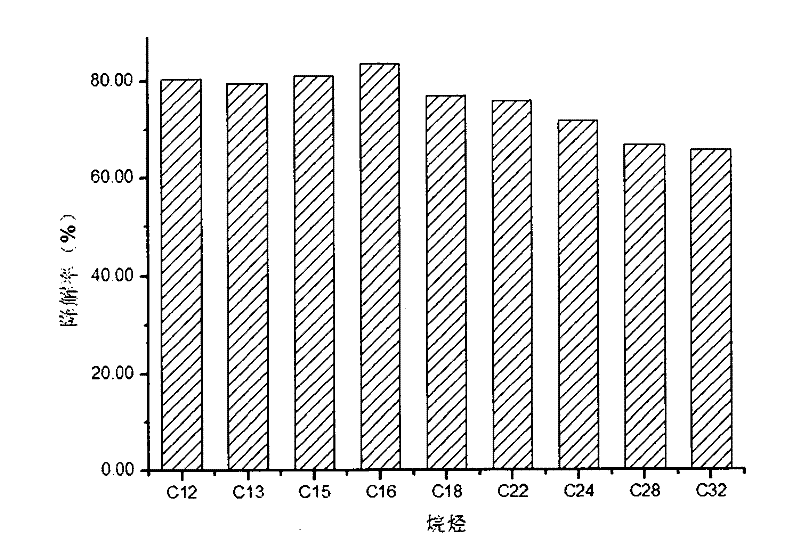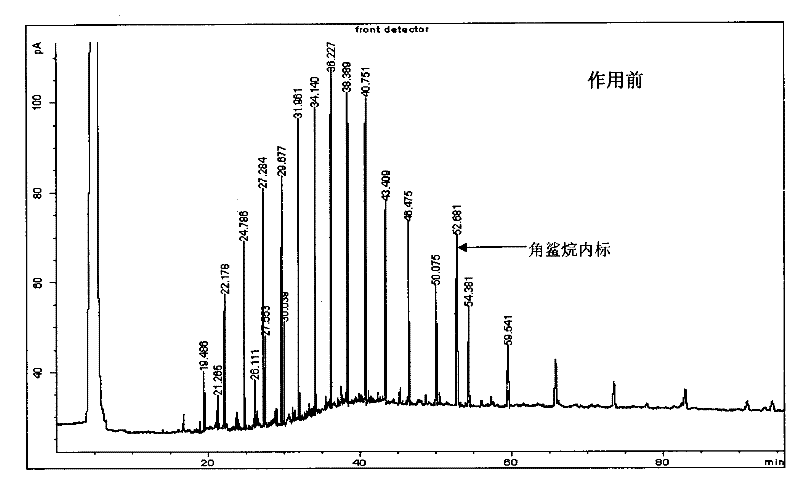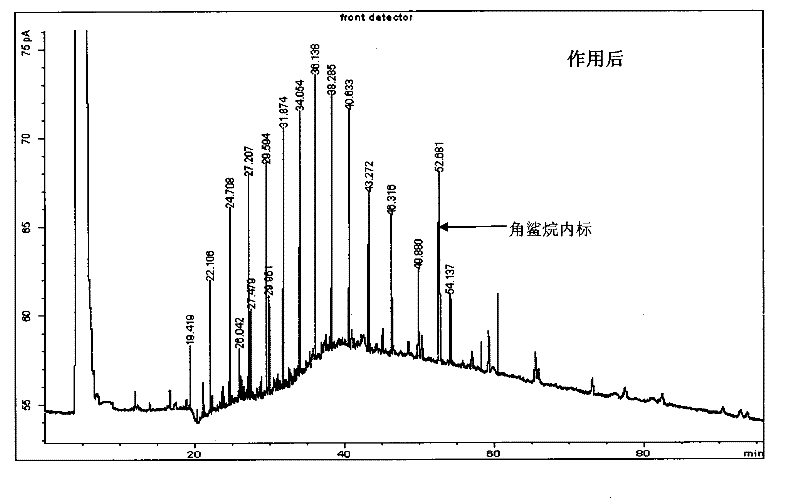Salt-tolerant Rhodococcus sp. JH for generating biological emulsifier and degrading alkane and application thereof in bioremediation of petroleum polluted saline-alkali soil
A biological emulsifier and oil pollution technology, applied in the field of microbial biotechnology and environmental biology, can solve the problems of oil pollution and achieve the effect of improving the degradation rate
- Summary
- Abstract
- Description
- Claims
- Application Information
AI Technical Summary
Problems solved by technology
Method used
Image
Examples
Embodiment 1
[0048] Isolation and screening of Rhodococcus sp.JH bacterial strain provided by the invention
[0049] Get 1g of the oil-contaminated saline-alkaline soil sample, and inoculate it into 100ml of inorganic salt liquid wax medium aseptically (the medium composition: Na 2 HPO 4 1.5g; KH 2 PO 4 3.48g; MgSO 4 0.7g; (NH 4 ) 2 SO 4 4g; yeast powder 0.01g; liquid paraffin 2% (v / w), distilled water 1000ml; pH natural; sterilized at 121°C for 30min), cultured on a shaker at 37°C for 5 days. The enriched culture solution was thoroughly mixed, 100 μl was taken and spread on a 1.5% LB solid plate, cultured in a constant temperature incubator at 37°C for 2-3 days, and the grown colonies were observed. Single colonies were picked and checked for purity using a microscope. Each grown colony was inoculated into LB medium and cultivated to OD 630 It is about 0.8, and it is inserted into 100 ml of inorganic salt liquid wax medium as a seed solution at a ratio of 10% (v / v), and cultured ...
Embodiment 2
[0053] PCR Amplification and Sequence Determination of 16S rRNA Gene of Rhodococcus sp.JH Strain
[0054] Rhodococcus sp.JH CGMCC No.3388 was inoculated in LB medium, cultured on a shaker at 37°C (130rpm) for 16 hours, collected by centrifugation, resuspended, added lysozyme and SDS to break the wall, and extracted genomic DNA by the phenol-chloroform method. And using the forward primer 27F (5'-GAGAGTTTGATCCTGGCTCAG-3') and the reverse primer 1541R (5'-AAGGAGGTGATCCAGCC-3'), use this pair of primers to perform PCR amplification on its 16S rRNA gene, and send the amplification primers to Shanghai Workers were sequenced. The PCR conditions are: 94°C, 10min; 94°C, 45s, 55°C, 45s, 72°C, 90s, 30 cycles; 72°C, 10min, 4°C storage. The length of the 16S rRNA gene sequence is 1479bp, and the accession number in GenBank is HM134277, which has a sequence similarity of 97% with the 16S rRNA (accession number: NR 026185) of Rhodococcus ruber strain: DSM43338. The sequence of its 16S rRN...
Embodiment 3
[0056] The Rhodococcus sp.JH bacterial strain provided by the present invention degrades alkanes and crude oil from Binnan Oil Production Plant of Shengli Oilfield. Activate the bacterial strain on an LB plate, take a single colony and insert it into 5ml LB liquid medium for overnight culture, and inoculate with 1% inoculum Into 100ml LB liquid culture medium, 37 ℃ of shaking cultures 5h to logarithmic growth phase, inoculate with 100ml inorganic salt culture medium that contains different alkanes or crude oil as carbon source with 10% inoculum size (medium composition is the same as embodiment 1 ) in an Erlenmeyer flask, cultured at 37°C for 3 days, analyzed by gas chromatography, the degradation rate of the strain to alkanes with different carbon numbers, measured the degradation rate of crude oil with infrared oil measuring instrument and carried out gas chromatography of residual crude oil with high pressure gas chromatography analysis, the result is as figure 1 and figu...
PUM
| Property | Measurement | Unit |
|---|---|---|
| diameter | aaaaa | aaaaa |
Abstract
Description
Claims
Application Information
 Login to View More
Login to View More - R&D
- Intellectual Property
- Life Sciences
- Materials
- Tech Scout
- Unparalleled Data Quality
- Higher Quality Content
- 60% Fewer Hallucinations
Browse by: Latest US Patents, China's latest patents, Technical Efficacy Thesaurus, Application Domain, Technology Topic, Popular Technical Reports.
© 2025 PatSnap. All rights reserved.Legal|Privacy policy|Modern Slavery Act Transparency Statement|Sitemap|About US| Contact US: help@patsnap.com



